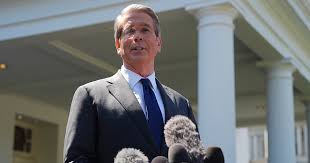US Treasury Secretary Slams India as ‘Recalcitrant’ in Trade Talks After Trump’s New Tariffs
In a fresh twist to the simmering trade tensions between the United States and India, US Treasury Secretary Janet Yellen has described India as “recalcitrant” in ongoing trade negotiations, just days after President Donald Trump imposed a new wave of tariffs on Indian goods. The move marks another escalation in the complex trade relationship between the world’s largest and most populous democracies, setting the stage for potentially prolonged economic friction.

This development is not just about numbers on paper or tariffs on products — it reflects deeper disagreements over trade policy, market access, and the rules of the global economy.
Tariffs as a Pressure Tactic
Last week, President Trump announced a fresh round of tariffs on Indian imports, citing what he described as “persistent unfair trade practices” and an imbalance in market access between the two nations. The tariffs cover a wide range of goods — from textiles and leather products to select engineering goods — and are expected to impact billions of dollars worth of bilateral trade.
While the White House insists that the move is aimed at creating a level playing field, Indian officials have described the decision as “unilateral” and “counterproductive.” For Washington, however, tariffs are a tried-and-tested negotiating tool, often deployed to push trading partners into concessions.
Janet Yellen’s Strong Words
Speaking at a press briefing following an international economic forum, Treasury Secretary Janet Yellen accused India of being “recalcitrant” — meaning stubbornly resistant — in trade talks.
Her comments come against the backdrop of stalled negotiations on several key issues:
- Lowering tariffs on US agricultural products like almonds, apples, and dairy items.
- Allowing greater market access for American technology and e-commerce companies.
- Intellectual property protections for US pharmaceutical and tech sectors.
Yellen suggested that India has been unwilling to move forward on “critical sticking points” despite repeated rounds of talks.
Why the US is Frustrated
The US has long complained about India’s relatively high tariff regime, restrictive regulations, and a cautious approach to opening its domestic market. For instance:
- The average applied tariff in India is much higher than that of most developed economies.
- Certain sectors, like agriculture and retail, are heavily protected to shield local farmers and small businesses.
- Rules on data localization and digital commerce make it harder for US tech giants to expand freely.
From Washington’s perspective, these policies hurt US exporters and investors, limiting the scope for a truly balanced trade relationship.
India’s Point of View
India, however, sees the matter differently. Officials in New Delhi argue that:
- The US already enjoys a trade surplus in services thanks to India’s outsourcing industry.
- India’s developing economy status means it needs the ability to protect vulnerable sectors from foreign competition.
- The country is already undertaking gradual liberalization, but changes cannot be made at the expense of domestic stability and livelihoods.
In short, India sees Trump’s tariffs — and Yellen’s tough talk — as attempts to pressure it into opening its markets too quickly.
The Political Angle
Trade disputes rarely happen in isolation; they are deeply influenced by political considerations. For Trump, taking a hard line on trade with major partners plays well with his political base, which has long supported his “America First” economic policies.
Yellen’s choice of the word “recalcitrant” also signals that the administration is preparing the public for a protracted standoff rather than a quick deal.
In India, Prime Minister Narendra Modi faces his own political pressures. Any sign of giving in to US demands — especially under tariff threats — could be portrayed domestically as a loss of sovereignty or an attack on local industries.
What’s at Stake Economically
The US and India share a robust $190+ billion trade relationship, but it’s one that has always been marked by disputes:
- Technology and Digital Trade: American firms like Amazon, Google, and Walmart-owned Flipkart see huge potential in India, but they face restrictions on pricing, inventory control, and data usage.
- Pharmaceuticals: India’s generic drug industry is a major exporter to the US, but intellectual property rights remain a contentious issue.
- Agriculture: The US wants India to lower tariffs on farm products, while India wants better access for its rice, shrimp, and textile exports.
A prolonged tariff war could disrupt supply chains, raise prices for consumers, and hurt exporters on both sides.
Global Implications
The dispute comes at a time when global trade tensions are already high, with multiple countries rethinking supply chains, reshoring industries, and imposing protectionist measures.
If the US and India — two major democratic economies — fail to resolve their differences, it could:
- Push India to deepen trade ties with alternative partners like the EU, ASEAN nations, or China.
- Reduce cooperation in strategic sectors like defense technology and renewable energy.
- Undermine the Quad alliance (US, India, Japan, Australia), which has an economic cooperation dimension alongside its security focus.
Possible Paths to Resolution
Experts suggest several ways forward:
- Targeted Trade Deals – Instead of aiming for an all-encompassing free trade agreement, both sides could start with sector-specific deals, focusing on areas of mutual benefit.
- Tariff Rollback in Exchange for Concessions – The US could scale back tariffs if India makes targeted market-opening moves in agriculture and e-commerce.
- Leveraging Strategic Ties – Given that the US and India share strategic interests in countering China’s influence, both could use that alignment to foster goodwill in trade negotiations.
- Mediation through Global Forums – The World Trade Organization (WTO) or G20 could provide a platform for structured dialogue.
Public Reaction and Market Response
The announcement of new tariffs and Yellen’s remarks have already had an impact:
- Indian stock markets saw a mild dip, particularly in export-driven sectors like textiles and engineering goods.
- US companies with significant operations in India are reportedly lobbying for a more conciliatory approach to avoid disruptions.
- Social media in both countries lit up with debates, with some praising the US for defending its economic interests and others criticizing the move as heavy-handed diplomacy.
A Relationship Worth Preserving
While the rhetoric on both sides has sharpened, it’s worth noting that the US-India relationship extends far beyond trade. Both nations cooperate extensively in defense, counterterrorism, education, and technology innovation.
The current tariff fight and accusations of “recalcitrance” may make headlines, but history suggests that Washington and New Delhi eventually find ways to work through disputes — often by striking a delicate balance between economic pragmatism and political pride.
For now, however, business leaders and policymakers alike will be watching closely, as the outcome of this standoff could shape the future of US-India economic relations for years to come.
Follow us for more news at Valleynewz.com

